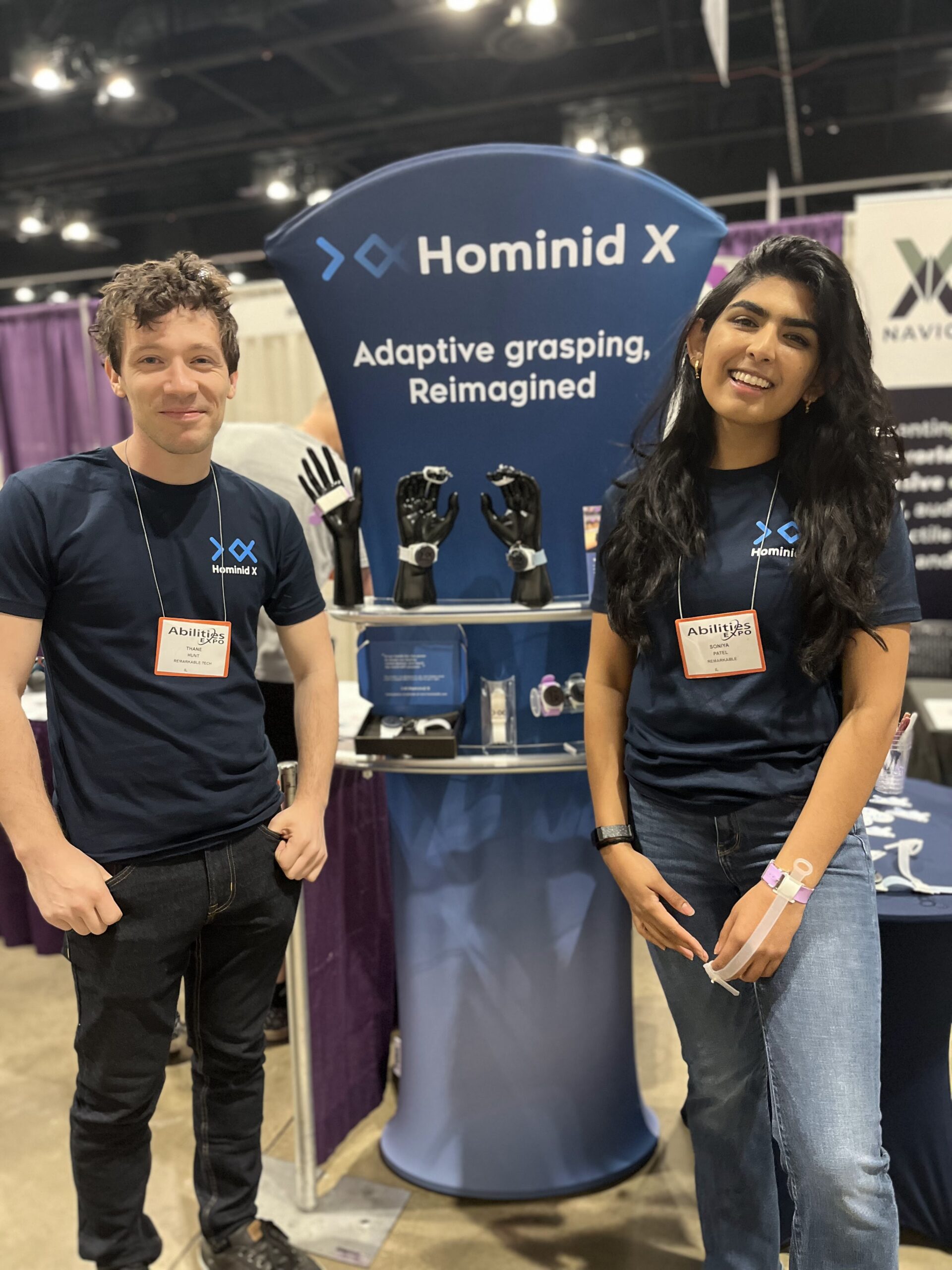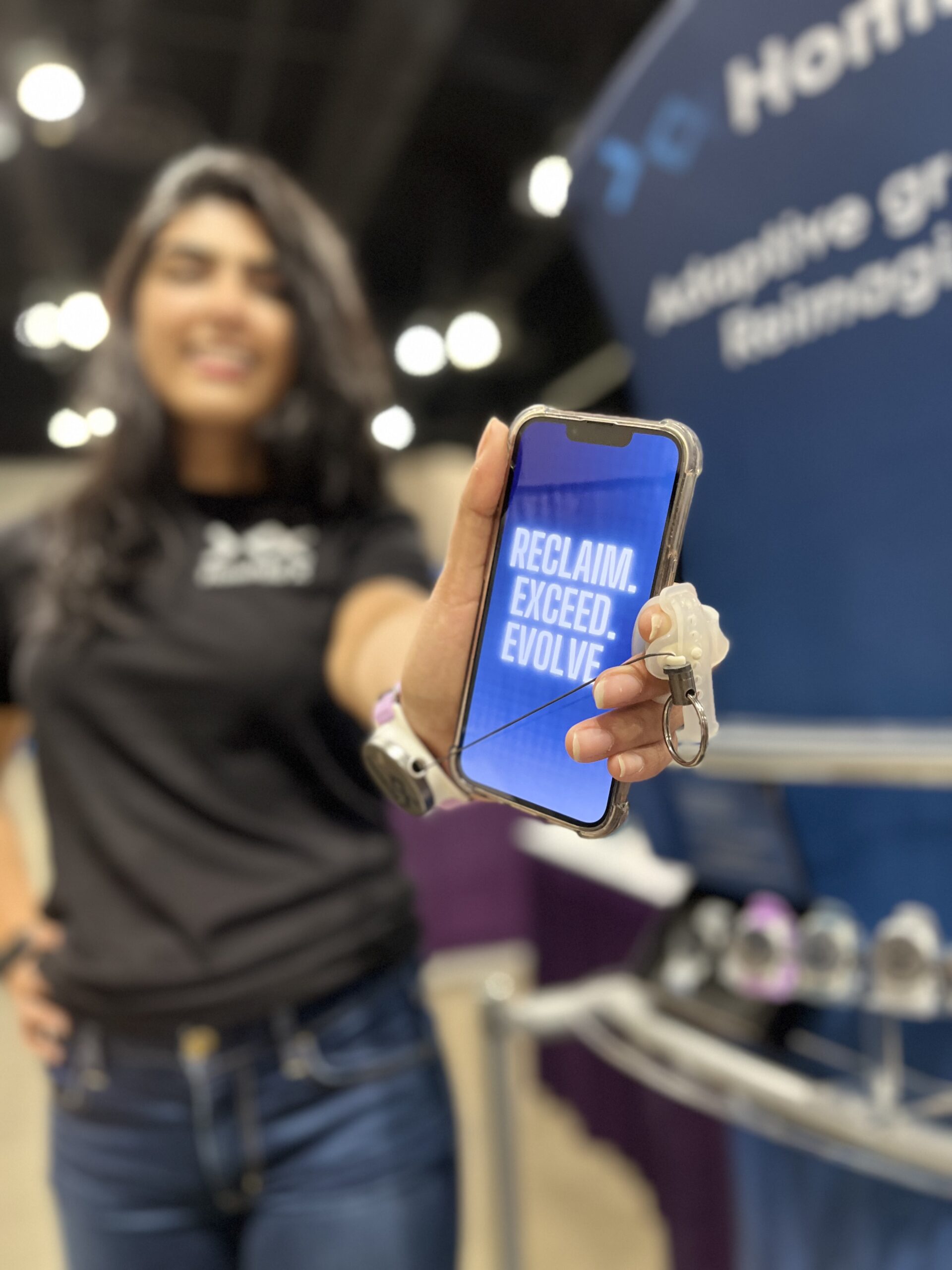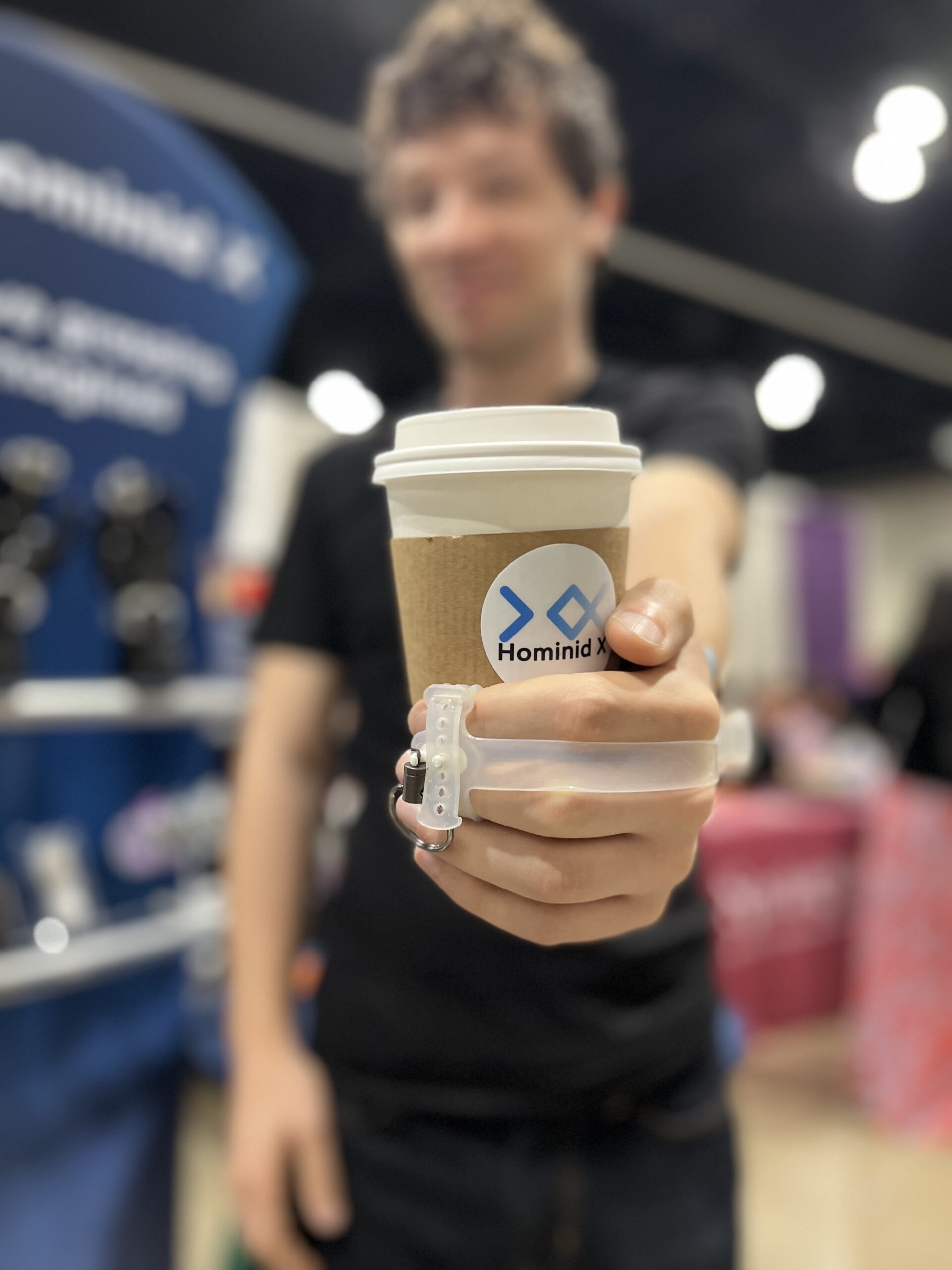In a time when 3D printing is making significant contributions to the medical sector, Hominid X stands out as a company harnessing this technology to address real-world issues. Recently interviewed by 3DPrint.com, co-founders Soniya Patel and Thane Hunt discuss their flagship product, Fiber. This assistive grasping device aims to restore hand function to individuals affected by conditions like spinal cord injuries, stroke, and neurodegenerative diseases. In the United States, where around 200,000 adults suffer strokes annually, many of whom lose significant hand function, Fiber offers an affordable and practical solution. The device exemplifies the transformative impact of engineering when tailored to address specific human needs.
The founders bring extensive experience in 3D printing to the table, with Patel having worked in the additive division at Stryker and Desktop Metal, while Hunt served as a senior systems engineer at both Desktop Metal and Formlabs.
 Hominid X co-founders Thane Hunt and Soniya Patel. Image courtesy of Hominid X.
Hominid X co-founders Thane Hunt and Soniya Patel. Image courtesy of Hominid X.At Hominid X, 3D printing is more than just a prototyping tool; it’s a cornerstone of their approach to assistive technology. Leveraging their extensive background in the field, Patel and Hunt have found ways to use 3D printing not just for early-stage designs but also for small-scale production. This nuanced application of the technology enables them to iterate and optimize their products rapidly. Through a blend of thermoplastic elastomers and silicone, the duo managed to create a product that is functional and comfortable for the end-user. Their experience has led them to develop new frameworks and philosophies that guide the efficient transition from prototyping to production, bridging the technological gaps that often slow down startups in this space.
“Modern 3D printers, with their sensor-based feedback and closed-loop features, are essentially robots,” explains Hunt, whose background in robotics and manufacturing equips him to navigate the complex interplay between mechanical, electrical, and software components, which has been invaluable for the company’s projects.
From the start, 3D printing played a significant role in developing and manufacturing the assistive device. The technology was vital in the rapid prototyping phase, where the founders experimented with different materials and printing techniques like fused deposition modeling (FDM) and digital light processing (DLP). Using 3D printing, they could quickly go from concept to a tangible prototype, testing multiple designs rapidly. They also innovatively used 3D printing to create molds for their final product, bridging the gap between prototyping and large-scale production. They explain that by the time they ordered their official aluminum and steel molds for mass production, they were already 99% confident in the design, highlighting the technology’s transformative impact in optimizing the entire manufacturing process.
With patients at heart
Interestingly, Hominid X’s first product, Fiber, doesn’t include electrical parts or software. It’s purely mechanical and designed to help people who have difficulties grasping objects due to conditions like cerebral palsy, stroke, and arthritis. This aligns well with the founders’ diverse backgrounds and focuses on “solving real-world problems first, rather than showcasing engineering prowess.”
 Hominid X’s Fiber assistive grasping device. Image courtesy of Hominid X.
Hominid X’s Fiber assistive grasping device. Image courtesy of Hominid X.Unfortunately, not all healthcare systems are prepared to welcome innovations like Fiber. Insurance companies have yet to be proactive in incorporating it into their plans despite its potential to get people back into the workforce and reduce disability payments. “They’re very reactive,” notes Patel, revealing that the company is strategically pricing Fiber at around $99 to bypass the need for insurance. This approach has led to minimal pushback on the price point in the US, though international markets pose their challenges.
Navigating the disability tech space involves engaging with “super-motivated users, well-meaning but skeptical doctors and clinicians, and insurance companies whose goal is to minimize payout.” This complex ecosystem has driven Hominid X to innovate continually, leveraging 3D printing to expedite the design process and testing with users, who often discover the product through occupational therapists (who tend to get very excited about the product).
 Soniya Patel shows how Fiber can be used. Image courtesy of Hominid X.
Soniya Patel shows how Fiber can be used. Image courtesy of Hominid X.According to the founders, therapists are “the number-one champions” of Hominid X’s products. They are motivated purely by the functional recovery of their clients. They are excited about assistive devices that can offer immediate benefits, especially when full recovery is long-term or uncertain.
Hunt used his past work with people who have different types of arm and hand problems to guide him. These problems could be due to missing limbs or being born with them differently than most people. He noticed that many existing helping tools don’t meet basic needs. For example, they might be too heavy, expensive, or hard to clean. This understanding helped Hominid X decide how to start making their tool. They knew they needed to create something that people would at least try; it should be inexpensive, lightweight, aesthetically pleasing, versatile in the types of grips they offer, minimally invasive on the skin, and washable for daily life uses like eating. Hunt argues that the assistive device industry has often been focused on engineering solutions without enough input from the end-users. So the founders knew they needed to create something that people would at least try out, and it evolved into what it is today through ongoing conversations with those users.
 Hominid X Fiber in different colors. Image courtesy of Hominid X.
Hominid X Fiber in different colors. Image courtesy of Hominid X.One of the most compelling aspects of Hominid X’s Fiber product is its profound impact on its users’ lives. For example, Paulette Bergounous, a polio survivor who now grapples with post-polio syndrome, says that after 77 years, she experienced the sensation of holding a glass in her right hand, a simple joy made possible by Fiber. “The sensation is indescribable,” she explains, relating how she even walks around her home holding an empty plastic glass to enjoy what she describes as a “normal” feeling.
On the other side of the spectrum is Megan Beth, a youth stroke survivor who has turned her challenges into a popular TikTok channel featuring cooking and lifestyle videos for her 30,000 followers. With Fiber, Megan shares how she can now open cans and hold cups, mundane tasks that have become significant milestones in her life. “I haven’t been able to eat something and walk at the same time for so long,” she tells followers. Another life-changing story comes from Felix Gretarsson, who underwent one of the world’s first double arm and shoulder transplant in 2021. After decades without both arms, Felix is not only back in the gym and driving but has also returned to cycling, thanks to the added gripping strength provided by Fiber.
@m3ganb3th Thank goodness for my Fiber. 🤌 #poststrokerecovery #lefthemiparesis #lefthemiplegia #handdisability #hominidx #TheFiberHand
Going global
While most of Hominid X’s customers are based in the US, the company has started advancing into other markets like Spain, France, and Canada. Still, it acknowledges the need for more localized approaches: “The Japanese market, for example, could benefit from our product. It’s just a matter of finding the right balance between stabilizing our current operations and expanding,” says Patel.
Hominid X is now working on a pediatric-size version of Fiber, catering to the anatomical differences in children’s hands. Additionally, Hunt hints at more advanced, possibly electronic products in the future, stating it’s “the obvious next place to go.”
 Thane Hunt shows how Fiber can be used. Image courtesy of Hominid X.
Thane Hunt shows how Fiber can be used. Image courtesy of Hominid X.With a vision, expertise, and an understanding of user needs, Patel and Hunt claim there are endless possibilities when technology is harnessed to make meaningful changes in people’s lives. With a user base that potentially extends to over 200 million people worldwide, the sky is the limit for this innovative company.
With a vision, expertise, and an in-depth understanding of user needs, Patel and Hunt claim there are many possibilities when technology is harnessed to make meaningful changes in people’s lives. They point out that the market is complex, comprising a wide array of medical conditions that can result in grasping and holding disabilities—ranging from stroke-induced hemiplegia to cerebral palsy, spinal cord injuries, Parkinson’s disease, ALS, MS, muscular dystrophy, and various neurological and orthopedic injuries. While the manifestations of these conditions may differ, they often face the same issue: the weakened ability to grasp objects. This widespread need highlights the significance of their work; with over 200 million people around the globe facing such disabilities, the scope of impact for Hominid X is tremendous.
Subscribe to Our Email Newsletter
Stay up-to-date on all the latest news from the 3D printing industry and receive information and offers from third party vendors.
You May Also Like
Gorilla Sports GE’s First 3D Printed Titanium Cast
How do you help a gorilla with a broken arm? Sounds like the start of a bad joke a zookeeper might tell, but it’s an actual dilemma recently faced by...
Nylon 3D Printed Parts Made More Functional with Coatings & Colors
Parts 3D printed from polyamide (PA, Nylon) 12 using powder bed fusion (PBF) are a mainstay in the additive manufacturing (AM) industry. While post-finishing processes have improved the porosity of...
$25M to Back Sintavia’s Largest Expansion of Metal 3D Printing Capacity Since 2019
Sintavia, the digital manufacturing company specializing in mission-critical parts for strategic sectors, announced a $25 million investment to increase its production capacity, the largest expansion to its operations since 2019....
Velo3D Initiates Public Offering in a Bid to Strengthen Financial Foundations and Drive Future Growth
Velo3D (NYSE: VLD) has been among a number of publicly traded 3D printing firms that have attempted to weather the current macroeconomic climate. After posting a challenging financial report for 2023,...































